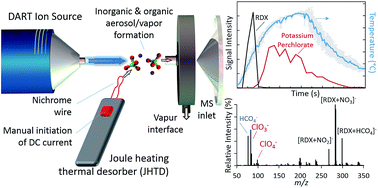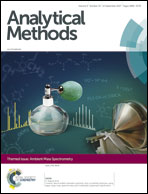Abstract
An ambient mass spectrometry (MS) platform coupling resistive Joule heating thermal desorption (JHTD) and direct analysis in real time (DART) was implemented for the analysis of inorganic nitrite, nitrate, chlorate, and perchlorate salts. The resistive heating component generated discrete and rapid heating ramps and elevated temperatures, up to approximately 400 °C s−1 and 750 °C, by passing a few amperes of DC current through a nichrome wire. JHTD enhanced the utility and capabilities of traditional DART-MS for the trace detection of previously difficult to detect inorganic compounds. A partial factorial design of experiments (DOE) was implemented for the systematic evaluation of five system parameters. A base set of conditions for JHTD-DART-MS was derived from this evaluation, demonstrating sensitive detection of a range of inorganic oxidizer salts, down to single nanogram levels. DOE also identified JHTD filament current and in-source collision induced dissociation (CID) energy as inducing the greatest effect on system response. Tuning of JHTD current provided a method for controlling the relative degrees of thermal desorption and thermal decomposition. Furthermore, in-source CID provided manipulation of adduct and cluster fragmentation, optimizing the detection of molecular anion species. Finally, the differential thermal desorption nature of the JHTD-DART platform demonstrated efficient desorption and detection of organic and inorganic explosive mixtures, with each desorbing at its respective optimal temperature.

- This article is part of the themed collection: Ambient Mass Spectrometry


 Please wait while we load your content...
Please wait while we load your content...